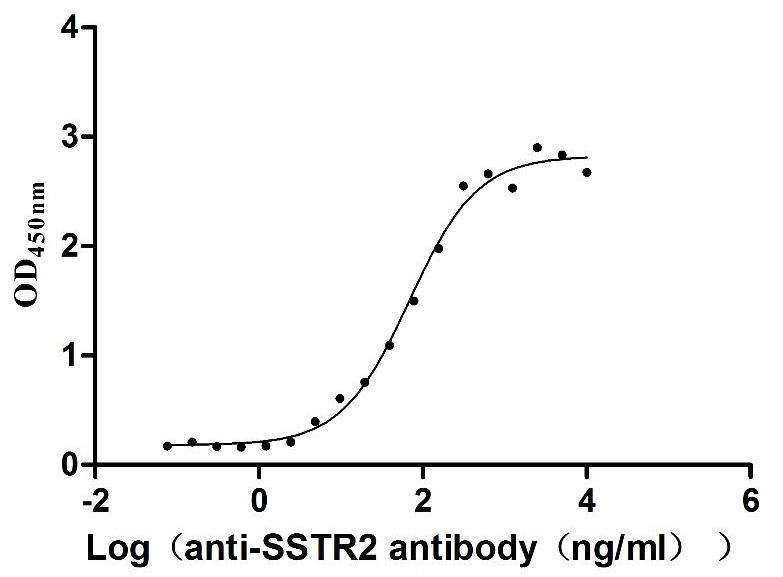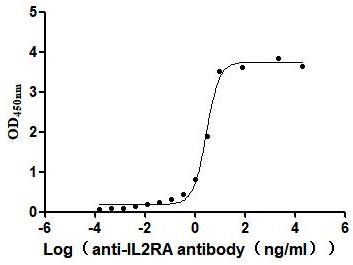Recombinant Mouse Excitatory amino acid transporter 1 (Slc1a3), partial
-
中文名称:小鼠Slc1a3重组蛋白
-
货号:CSB-YP021434MO
-
规格:
-
来源:Yeast
-
其他:
-
中文名称:小鼠Slc1a3重组蛋白
-
货号:CSB-EP021434MO
-
规格:
-
来源:E.coli
-
其他:
-
中文名称:小鼠Slc1a3重组蛋白
-
货号:CSB-EP021434MO-B
-
规格:
-
来源:E.coli
-
共轭:Avi-tag Biotinylated
E. coli biotin ligase (BirA) is highly specific in covalently attaching biotin to the 15 amino acid AviTag peptide. This recombinant protein was biotinylated in vivo by AviTag-BirA technology, which method is BriA catalyzes amide linkage between the biotin and the specific lysine of the AviTag.
-
其他:
-
中文名称:小鼠Slc1a3重组蛋白
-
货号:CSB-BP021434MO
-
规格:
-
来源:Baculovirus
-
其他:
-
中文名称:小鼠Slc1a3重组蛋白
-
货号:CSB-MP021434MO
-
规格:
-
来源:Mammalian cell
-
其他:
产品详情
-
纯度:>85% (SDS-PAGE)
-
基因名:
-
Uniprot No.:
-
别名:Slc1a3; Eaat1; Gmt1Excitatory amino acid transporter 1; Glial high affinity glutamate transporter; High-affinity neuronal glutamate transporter; GluT-1; Sodium-dependent glutamate/aspartate transporter 1; GLAST-1; Solute carrier family 1 member 3
-
种属:Mus musculus (Mouse)
-
蛋白长度:Partial
-
蛋白标签:Tag type will be determined during the manufacturing process.
The tag type will be determined during production process. If you have specified tag type, please tell us and we will develop the specified tag preferentially. -
产品提供形式:Lyophilized powder
Note: We will preferentially ship the format that we have in stock, however, if you have any special requirement for the format, please remark your requirement when placing the order, we will prepare according to your demand. -
复溶:We recommend that this vial be briefly centrifuged prior to opening to bring the contents to the bottom. Please reconstitute protein in deionized sterile water to a concentration of 0.1-1.0 mg/mL.We recommend to add 5-50% of glycerol (final concentration) and aliquot for long-term storage at -20℃/-80℃. Our default final concentration of glycerol is 50%. Customers could use it as reference.
-
储存条件:Store at -20°C/-80°C upon receipt, aliquoting is necessary for mutiple use. Avoid repeated freeze-thaw cycles.
-
保质期:The shelf life is related to many factors, storage state, buffer ingredients, storage temperature and the stability of the protein itself.
Generally, the shelf life of liquid form is 6 months at -20°C/-80°C. The shelf life of lyophilized form is 12 months at -20°C/-80°C. -
货期:Delivery time may differ from different purchasing way or location, please kindly consult your local distributors for specific delivery time.Note: All of our proteins are default shipped with normal blue ice packs, if you request to ship with dry ice, please communicate with us in advance and extra fees will be charged.
-
注意事项:Repeated freezing and thawing is not recommended. Store working aliquots at 4°C for up to one week.
-
Datasheet :Please contact us to get it.
靶点详情
-
功能:Sodium-dependent, high-affinity amino acid transporter that mediates the uptake of L-glutamate and also L-aspartate and D-aspartate. Functions as a symporter that transports one amino acid molecule together with two or three Na(+) ions and one proton, in parallel with the counter-transport of one K(+) ion. Plays a redundant role in the rapid removal of released glutamate from the synaptic cleft, which is essential for terminating the postsynaptic action of glutamate.
-
基因功能参考文献:
- glutamate transporter function by GLAST on Bergmann glia plays important roles in development and maintenance of proper synaptic wiring and wrapping in Purkinje cells PMID: 28655840
- Loss of EAAT4 accounts for the initial hyper-excitability of Purkinje cells lacking b-III spectrin and that loss of GLAST appears to work synergistically to worsen motor deficits. When levels of both EAAT4 and GLAST are compromised in b-III(-/-) mice, the proximal dendrites of Purkinje cells within the posterior cerebellum are the most vulnerable to degeneration. PMID: 28173092
- The results of this study concluded that EAAT anion channels play an important and unexpected role in adjusting glial intracellular anion concentration during maturation and in response to cerebellar activity. PMID: 27859594
- SLC1A3 maintains a constant import of acidic amino acids independently of nutritional status in adipocytes. PMID: 28032905
- glutamate/aspartate transporter (GLAST) was elevated in 8- to 10- and/or 20- to 22-month GHR-KO mice when comparing genotypes PMID: 25711529
- This study findings demonstrate that Ascl1(CreERT2) and Glast(CreERT2) mouse lines enable simple and reliable labeling of adult-born GC lineages within restricted time windows. PMID: 26586824
- arundic acid treatment prevented RGC death by upregulating GLAST in heterozygous (GLAST(+/-)) mice PMID: 25789968
- Results show that expression of GLAST is decreased in cerebellar astrocytes in a mouse model of SCA1; decrease occurs in non-cell autonomous manner late in disease and correlates well with the loss of Purkinje neurons PMID: 25255716
- The result showed significant correlation between changes in GLUT 8 and glucose levels with changes in StAR level in the testis and circulating testosterone level in the mice from birth to senescence PMID: 25078271
- EAAT1 activity and sodium potassium-ATPase activity are co-regulated by a tightly coupled homeostatic relationship in astrocytes. PMID: 24095695
- TNR is expressed in a subset of astrocytes and contributes to glutamate homeostasis by regulating astrocytic GLAST expression. PMID: 24337573
- Results suggest that an impairment of astrocytic ascorbate-release may exacerbate neuronal dysfunction in neurodegenerative disorders and acute brain injury in which excitotoxicity and/or GLAST deregulation have been implicated. PMID: 22886112
- deletion appeared to preferentially affect the maintenance of a normal postsynaptic/neuronal phenotype, evident only with increasing age PMID: 22350511
- BDNF can up-regulate GLAST and GS and increase glutamate uptake during hypoxia, and these functions may underlie its neuroprotective effects. PMID: 21448920
- Together, these studies strongly suggest that NF-kappaB contributes to neuron-dependent regulation of astrocytic GLT-1 transcription. PMID: 21697367
- Glutamate substrate increases GLAST activity and up-regulates the expression of GLAST protein in retinal Muller cells. PMID: 18844020
- Increased susceptibility to seizures in GLAST (-/-) mice is due to increased Glu-R1 in the hippocampus coupled with decreased cortical Glu-R2 and increased NMDA-R1 and -2A, -2B expression. PMID: 12225864
- GLT-1 and GLAST glutamate transporters are early and selectively expressed in barrel cortex of newborn mice. Confocal and electron microscopy confirm that the expression is restricted to the astroglial membrane. PMID: 12967927
- This study found that the retinal GABA level was about two-fold higher in the GLAST-/- mouse retina compared to that in the wild type. Endogenous glutamate level was also increased about 2-fold in the mutant. PMID: 15305132
- Glutamate uptake assays indicated that the Km value for glutamate uptake was similar in wild-type and GLAST-/- mouse retinas PMID: 15390100
- Lactate production and release not altered in retinas of GLAST -/- mice, suggesting that metabolic coupling between photoreceptors and Muller cells is not mediated by glial glutamate transporter, GLAST. PMID: 15579226
- GLAST protein contributes mainly to the uptake of glutamate that floods out of the synaptic cleft at early times after transmitter release. PMID: 16177048
- Tg mice carrying the human FRDP-17 mutant of tau protein manifest compromised motor function that correlates with altered expression of the glial glutamate-aspartate transporter and occurs before the development of tau pathology. PMID: 16407562
- Decreased glutamate transporter is associated with Niemann-Pick disease, type C PMID: 16429462
- This result demonstrates that GLAST plays a role in preventing excitotoxic cerebellar damage after ischemia in concert with EAAT4. PMID: 16647773
- evidence for a Glu-dependent regulation of GLAST protein levels and activity, and an increase in AP-1 DNA binding activity to the glast promoter that is strictly dependent on AMPA receptor activation was found PMID: 17151912
- Data show that GLT-1 of EL mice at 5 weeks of age decreased more than those of DDY at the same age. PMID: 18621028
- EAATs play an early homeostatic and protective role in the pathologic milieu. Moreover, the differential profiles of injury produced by oxidative and excitotoxic insults identify two distinct phases of injury which parallel important aspects of ALS. PMID: 18661557
- GLAST-deficient mice exhibited abnormalities on certain behavioral measures considered relevant to the negative and attentional/cognitive symptoms of schizophrenia PMID: 19078949
收起更多
-
亚细胞定位:Cell membrane; Multi-pass membrane protein.
-
蛋白家族:Dicarboxylate/amino acid:cation symporter (DAACS) (TC 2.A.23) family, SLC1A3 subfamily
-
组织特异性:Detected in brain, in Bergmann glia arborising into the molecular layer of the cerebellum (at protein level). Localized in brain and is highly enriched in the Purkinje cell layer in cerebellum. Intermediate level in lung, low level in spleen, skeletal mus
-
数据库链接:


















